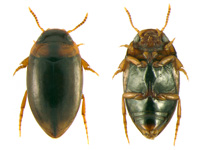Abstract
Aedes (Ochlerotatus) sallumae González & Reyes n. sp. is described and validated using morphological characters of the adult male and female, male genitalia and immature stages, and its cytochrome oxidase unit 1 mitochondrial gene sequence (COI). Aedes (Och.) sallumae is morphologically close to Ae. (Och.) albifasciatus (Macquart). However, these species can be distinguished based on characters of the males and females, male genitalia and fourth-instar larvae. Aedes (Och.) sallumae was collected in the geographically isolated desert zone of northern Chile, the Atacama Desert. This isolation suggests allopatric speciation, with Ae. (Och.) sallumae divergent from its sister species Ae. (Och.) albifasciatus. Molecular characterization showed a difference of more than 8% between these species, supporting their recognition as different species.
References
Angulo, A.O. & Olivares, T. (1993) Catálogo de los culícidos de Chile (Diptera Culicidae), y dos especies nuevas de Culex (Culex) Linnaeus. Boletín de la Sociedad de Biología de Concepción, 64, 21–26.
Black, W. (2004) Learning to use Ochlerotatus is just the beginning. Journal of the American Mosquito Control Association, 20, 215–216.
Bos, D.H. & Posada, D. (2005) Using models of nucleotide evolution to build phylogenetic trees. Developmental and Comparative Immunology, 29, 211–227.
https://doi.org/10.1016/j.dci.2004.07.007Edman, J.D. (2005) Journal policy on names of aedine mosquito genera and subgenera. Journal of Medical Entomology, 42, 511.
https://doi.org/10.1093/jmedent/42.4.511Edwards, F.W. (1917) Notes on Culicidae, with description of new species. Bulletin of Entomological Research, 7, 201–229.
https://doi.org/10.1017/S0007485300017557Edwards, F.W. (1932) Diptera Family Culicidae. In: Wytsman, P. (Ed.), Genera Insectorum, Fascicle 194, pp. 1–258.
Figueroa, A., Contreras, M., Saavedra, B. & Espoz, C. (2017) Chilean wetlands: biodiversity, endemism, and conservation challenges. In: Finlayson, C.M. et al. (Eds) The Wetland Book I: Structure and Function, Management and Methods. Springer, Dordrecht, pp. 1–307.
Folmer, O., Black, M., Hoeh, W., Lutz, R. & Vrijenhoek, R. (1994) DNA primers for amplification of mitochondrial cytochrome c oxidase subunit I from diverse metazoan invertebrates. Molecular Marine Biology and Biotechnology, 3, 294–299.
Frías, D. (2010) A new species and karyotype variation in the bordering distribution of Mepraia spinolai (Porter) and Mepraia gajardoi Frías et al. (Hemiptera: Reduviidae: Triatominae) in Chile and its parapatric model of speciation. Neotropical Entomology, 39 (4), 572–583.
https://doi.org/10.1590/S1519-566X2010000400017Garreaud, R.D., Molina, A. & Farías, M. (2010) Andean uplift, ocean cooling and Atacama hyperaridity: A climate modelling perspective. Earth and Planetary Science Letters, 292, 39–50.
https://doi.org/10.1016/j.epsl.2010.01.017Hall, T.A. (1999) BioEdit: a user-friendly biological sequence alignment editor and analysis program for windows 95/98/NT. Nucleic Acids Symposium Series, 41, 95–98.
Harbach, R.E. (2016) Mosquito Taxonomic Inventory. Available from: http://mosquito-taxonomic-inventory.info/ (accessed 29 August 2016)
Harbach, R.E. & Knight, K.L. (1980) Taxonomists’ glossary of mosquito anatomy. Plexus Publishing Inc. Marlton, New Jersey, 415 pp.
Kimura, M. (1980) A simple method for estimating evolutionary rates of base substitutions through comparative studies of nucleotide sequences. Journal of Molecular Evolution, 16, 111–120.
https://doi.org/10.1007/BF01731581Knight, K.L. & Stone, A. (1977) A catalog of the mosquitoes of the world (Diptera: Culicidae). Entomological Society of America, College Park, Maryland, 611 pp.
Kumar, N.P., Rajavel, A.R., Natarajan, R. & Jambulingam, P. (2007) DNA barcodes can distinguish species of Indian mosquitoes (Diptera: Culicidae). Journal of Medical Entomology, 44, 1–7.
https://doi.org/10.1093/jmedent/41.5.01Lynch-Arribálzaga, F. (1891) Dipterología argentina. Revista del Museo de La Plata, 1, 345–377.
Marshall, S.A. (2012) Flies: The natural history and diversity of Diptera. Firefly Books, Richmond Hill, Ontario, 616 pp.
Namin, H.H., Iranpour, M. & Sharanowski, B.J. (2014) Phylogenetics and molecular identification of the Ochlerotatus communis complex (Diptera: Culicidae) using DNA barcoding and polymerase chain reaction-restriction fragment length polymorphism. Canadian Entomologist, 146, 26–35.
https://doi.org/10.4039/tce.2013.60Nicholas, K.B., Nicholas, Jr. H.B. & Deerfield II, D.W. (1997) GeneDoc: analysis and visualization of genetic variation. Embnew News, 4, 14.
Nylander, J.A.A. (2004) MrModeltest v2. Program distributed by the autho, EBC, Uppsala University, Uppsala. [software]
Rambaut, A. (2008) FigTree v1.1.1: Tree figure drawing tool. Available from: http://tree.bio.ed.ac.uk/software/figtree/ (accessed 20 June 2008)
Rambaut, A., Suchard, M.A., Xie, D. & Drummond, A.J. (2014) Tracer v1.6. Available from: http://beast.bio.ed.ac.uk/Tracer (accessed 9 May 2017)
Reinert, J.F. (2000) New classification for the composite genus Aedes (Diptera: Culicidae: Aedini), elevation of subgenus Ochlerotatus to generic rank, reclassification of the other subgenera, and notes on certain subgenera and species. Journal of the American Mosquito Control Association, 16, 175–188.
Reinert, J.F., Harbach, R.E. & Kitching, I.J. (2008) Phylogeny and classification of Ochlerotatus and allied taxa (Diptera: Culicidae: Aedini) based on morphological data from all life stages. Zoological Journal of the Linnean Society, 153, 29–114.
https://doi.org/10.1111/j.1096-3642.2008.00382.xRondani, C. (1848) Esme di varie specie d’insetti ditteri brasiliani. Studi Entomologici, 1, 63–112.
Ronquist, F. & Huelsenbeck, J.P. (2003) MrBayes 3: Bayesian phylogenetic inference under mixed models. Bioinformatics, 19, 1572–1574.
https://doi.org/10.1093/bioinformatics/btg180Rozo-López, P. & Mengual, X. (2015) Mosquito species (Diptera, Culicidae) in three ecosystems from the Colombian Andes: identification through DNA barcoding and adult morphology. ZooKeys, 513, 39–64.
http://doi: 10.3897/zookeys.513.9561Rubinoff, D. (2006) DNA barcoding evolves into the familiar. Conservation Biology, 20, 1548–1549.
http://doi:10.1111/j.1523-1739.2006.00542.xSheppard, J.J., Adreadis, T.G. & Vossbrinck, C.R. (2006) Molecular phylogeny and evolutionary relationships among mosquitoes (Diptera: Culicidae) from the northeastern United States based on small subunit ribosomal DNA (18S rDNA) sequences. Journal of Medical Entomology, 43, 443–454.
https://doi.org/10.1093/jmedent/43.3.443Soto, M.V., Arriagada, J., Castro, C., Märker, M. & Rodolfi, G. (2010) Aspectos geodinámicos de un paleoestuario del desierto marginal de Chile. Río Copiapó. Revista de Geografía Norte Grande, 46, 123–135.
https://doi.org/10.4067/S0718-34022010000200007Tamura, K., Stecher, G., Peterson, N., Peterson, D., Filipski, A. & Kumar, S. (2013) MEGA6: Molecular evolutionary genetics analysis version 6.0. Molecular Biology and Evolution, 30, 2725–2729.
https://doi.org/10.1093/molbev/mst197Wilkerson, R.C., Linton, Y-M, Fonseca, D.M., Schultz, T.R., Price, D.C. & Strickman, D.A. (2015) Making mosquito taxonomy useful: A stable classification of Tribe Aedini that balances utility with current knowledge of evolutionary relationships. PLoS ONE, 10 (7), e0133602.
https://doi.org/10.1371/journal.pone.0133602

